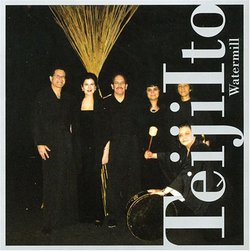| All Artists: Teiji Ito, Mara Purl, Yukio Tsuji Title: Teiji Ito: Watermill Members Wishing: 1 Total Copies: 0 Label: Tzadik Original Release Date: 1/1/2008 Re-Release Date: 8/19/2008 Genres: International Music, Classical Styles: Ballets & Dances, Ballets, Instruments, Electronic Number of Discs: 1 SwapaCD Credits: 1 UPC: 702397805823 |
Search - Teiji Ito, Mara Purl, Yukio Tsuji :: Teiji Ito: Watermill
 | Teiji Ito, Mara Purl, Yukio Tsuji Teiji Ito: Watermill Genres: International Music, Classical
|
Larger Image |
CD Details |
CD ReviewsA great lost work recovered! Steve Peters | Seattle, WA | 08/28/2008 (5 out of 5 stars) "Teiji Ito was a pioneer of what has come to be called "Downtown" (NYC) music. Freely combining elements of composition, improvisation, and electronics as well as many strands of world music and unusual instruments, he anticipated so many things that we now take for granted in contemporary/experimental music. Much of his work was made for film (perhaps most famously with his first wife, Maya Deren), theater, and dance.
Watermill was composed for the 1972 ballet of the same title by Jerome Robbins. It was Robbins' most controversial work, and one of his own personal favorites. A showcase for dancer Edward Villella, it was a stark, minimalist evocation of seasonal rituals, heavily influenced by traditional Japanese dance and music. Teiji died in 1982, but the ballet was revived in 1990 with new dancers (coached by Villella) and a new ensemble led by Teiji's brother Genji, and featuring Teiji's daughter Tavia, his fourth wife Cherel, and the flutist Dan Erkkila. Aside from a private cassette recording made at that time, the piece has remained unheard since then, lost in the red tape of the Robbins estate. Thankfully John Zorn has persisted in getting this work out as part of the series of crucial Ito releases on his Tzadik label. The original cassette recording mentioned above was a live recording. While the performance was quite stunning, the recording was not of sufficient quality to justify a commercial release. Watermill has been completely recreated for this CD, using the original recording as a template. Several key members of the 1990 ensemble having since died - Genji Ito, Cherel Ito, Dan Erkkila - this new recording is by a new ensemble led by world flute master Steve Gorn (a close friend of Erkkila) and Tavia Ito. It is scored for a number of familiar Japanese instruments (koto, shakuhachi, sho, ryuteki, hichiriki, taiko drums) as well as the Indian bansuri flute, zither, gongs, ocarina, and a variety of small percussion from African, Latin, Indian, and even Hawaiian traditions. The 53-minute work moves through seven distinct sections: a long, sparse prelude for shakuhachi and gong with vocal coda; an exuberant zither/flute duet with percussion; a stately meditative section influenced by gagaku (Japanese medieval court music) that features flute and koto; an extended passage for bamboo flutes with thumb piano and then steel drum over an eerie backing of high-pitched drones that suggest cicadas, punctuated by occasional sound effects (roaring jet, barking dog); a brief interlude for wispy flute overtones over spare percussion with wind noise and more dogs; a lovely koto/zither duet with melodic ocarina (?) and shakuhachi and spare percussion; and an epilogue for two shakuhachi (?) with very minimal gagaku-style percussion that morphs into a refrain of the opening. All of the sections flow together seamlessly to create a stunningly beautiful and dramatic listening experience. It's a great performance and an excellent recording. My only complaint is that I sometimes found myself wishing for a bit more "air" in the sound; all of the instruments are recorded very close up, and it would be nice if they could have done this in a larger room with just a bit more distance and natural room reverb. But this is a minor quibble, and I do realize that finding such spaces in New York City that are quiet enough for recording is a nearly impossible task. Overall this release is a cause for celebration, and a profound labor of love by all involved that restores Ito's lost masterpiece to its rightful place in the contemporary musical landscape. Big kudos to Zorn and company for bringing it back to life." |

 Track Listings (7) - Disc #1
Track Listings (7) - Disc #1